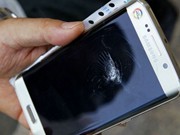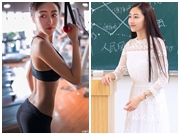

Guo Pei's gold evening gown is currently on view at the Metropolitan Museum of Art exhibition China: Through the Looking Glass.[Photo/China Daily]
Chinese style
For Guo, the "China style", is best represented by the country's imperial past, a view that was considered politically incorrect for a while in modern Chinese history.
But similar to how ruling families of Europe had once been patrons of artists and artisans of their day, ancient China's feudal dynasties amassed and commissioned vast amounts of artwork from paintings to carvings in jade for years.
"The pinnacle of Chinese art and craft were reached by works that belonged to a tradition and a bloodline of which I'd like to consider myself a successor."
For those who argue that Chinese style at its very top has a tradition for luxury, Guo's clothes stand as powerful examples.
Jiang Qiong'er, artistic director and CEO of Shang Xia, a China-based affiliate of French brand Hermes, has a different opinion on what constitutes Chinese aesthetics.
Founded in 2008, Shang Xia is touted as the country's first major luxury brand, and according to her, all its products - chairs, chess sets and teacups - are rooted in culture. "Spiritually, we don't belong to a royal tradition. Instead, we see ourselves as part of the country's scholarly tradition," Jiang says.
Citing the example of ancient Chinese poets, who were fiery within and appeared cool and composed on the outside, she explains that her brand's "dual-quality" philosophy means while her product designs may speak the language of minimalism, craftsmen have dedicated hours to refine each piece.
Jiang, who studied fashion both in China and France, also points to her brand's modernity.
Two red lacquer chairs that were auctioned by Christie's at 1,110,000 yuan ($180,000) last October, are so lightweight that they can be easily lifted but at the same time can sustain up to 250 kilograms of weight because they are made of carbon fiber.
But being modern doesn't mean abandoning tradition, she says, adding that Shang Xia's Paris store, which opened in 2013, is trying to spread this Chinese identity.
Today, as the disastrous effects of the "cultural revolution" (1966-76) slowly fade from public memory, China's fashion industry too is looking to find its feet as a more relaxed, creative place.
 |  |
Day|Week

 Father’s love is like a mountain
Father’s love is like a mountain Walnut too hard for cellphone screen
Walnut too hard for cellphone screen Girls in leaf bikinis perform pole dance on the beach
Girls in leaf bikinis perform pole dance on the beach Fascinating images of Jiuzhaigou Valley
Fascinating images of Jiuzhaigou Valley "Levitating" pole dancer
"Levitating" pole dancer Special armed police attend 'devil trainings' in Hunan
Special armed police attend 'devil trainings' in Hunan Top 10 terrifying tourist sites in China
Top 10 terrifying tourist sites in China Beautiful and smart - post-90s college teacher goes viral
Beautiful and smart - post-90s college teacher goes viral